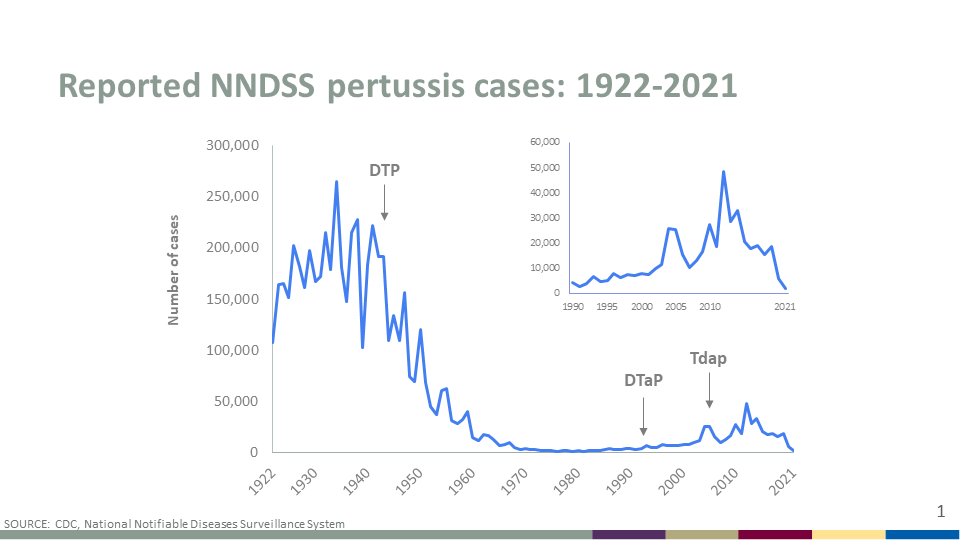
Factually inaccurate: Studies have found no association between the DTaP vaccine and sudden infant death syndrome (SIDS). Childhood vaccination isn’t a risk factor for SIDS.

FULL CLAIM: The whooping cough vaccine was never needed because deaths had declined before the vaccine was available; the DTaP vaccine is associated with sudden infant death syndrome
REVIEW
An Instagram reel posted in March 2024 suggested that the whooping cough vaccine was never needed, since whooping cough deaths had plummeted before the vaccine was available. It also implied that the DTaP vaccine is dangerous and associated with sudden infant death syndrome.
The reel’s caption concluded by advocating for people to let their immune systems “do its job, naturally”, in effect, implying people would be better off taking their chances with disease than if they got vaccinated.
The reel, which was posted by the Instagram account @you.dont.know.jac, was viewed more than 17,900 times. The account has more than 83,000 followers and is run by an individual named Jaclyn Simone, who also claims vaccines cause encephalitis and autism (they don’t) and promotes an oil that allegedly detoxes and treats autism (there’s no evidence this works).
The DTaP vaccine targets three diseases: diphtheria, tetanus, and pertussis (whooping cough). All three diseases are caused by toxin-producing bacteria. Unlike other vaccines which target the harmful microorganism, the DTaP vaccine targets the toxins that the microorganisms produce, as it is the toxins that produce the disease.
As we will explain below, the claims made in the reel misrepresent published articles in journals and potentially place people at risk of serious complications from vaccine-preventable diseases.
Looking at whooping cough incidence in addition to deaths provides a more complete picture of the vaccine’s impact
To support her suggestion that the whooping cough vaccine is unnecessary, Simone pointed to a graph of pertussis mortality in the U.S. It showed that deaths from whooping cough had declined before the 1940s, when the whooping cough vaccine became available.
Using reverse image search, we were able to identify a similar-looking graph published on this website, bearing the URL “healthsentinel.com” in a corner. The website healthsentinel.com is a now-defunct, anonymous website that pushed claims similar to those made in the reel, as can be seen in this archive.
The graph indicated that the data was sourced from the reports “Vital Statistics Rate in the United States 1940-1960” and the “Historical Statistics of the United States, Colonial Times to 1957”, published in 1968 and 1975, respectively.
Now, the issue with the claim isn’t that the data comes from unreliable sources or that it’s necessarily inaccurate, but that it provides a limited perspective of the vaccine’s impact on public health.
As David Gorski, a surgical oncologist and editor of Science-Based Medicine, explained in this 2010 article, deaths from various vaccine-preventable diseases did decline as a result of improvements in supportive care. For instance, the development of the iron lung meant that fewer children died from polio-associated paralysis of the breathing muscles.
However, looking only at deaths doesn’t give us the whole picture. We get a more complete understanding of the impact that vaccines had on infectious diseases when we look at the incidence rate as well as the mortality rate.
As we can see from the graph below, cases of whooping cough fell after the first combination diphtheria-tetanus-pertussis (DTP) vaccine was made available (Figure 1). In the 1940s, when the vaccine was first made available, the number of whooping cough cases frequently exceeded 100,000 cases per year. By 1965, reports fell to fewer than 10,000.

Figure 1 – Pertussis cases reported to the National Notifiable Diseases Surveillance System (NNDSS) in the United States. The DTP vaccine was the first combination vaccine against diphtheria, tetanus, and pertussis. This vaccine contained killed Bordetella pertussis, the causative agent of pertussis, in addition to the inactivated pertussis toxin. Its successor, the DTaP vaccine, contains only the pertussis toxin. The Tdap vaccine is given to those older than seven years old and is generally used as a booster for teenagers and adults. Source: NNDSS. Retrieved on 5 March 2024.
Moreover, focusing only on deaths means neglecting the diseases’ harmful impact on those who survive, as we will show below.
Getting diphtheria, tetanus, or whooping cough carries the risk of serious complications for survivors
As explained earlier, the three diseases that the DTaP vaccine targets are diseases caused by toxins from bacteria, namely Corynebacterium diphtheriae, Clostridium tetani, and Bordetella pertussis. This is why, unlike many other vaccines, the DTaP vaccine targets the toxins released by the bacteria rather than the bacteria themselves.
The Instagram reel advocated for people to allow nature to take its course, implicitly encouraging infection in lieu of vaccination. However, all three diseases can produce great distress and potentially serious complications, even if they don’t ultimately kill.
Whooping cough causes the body to produce very thick mucus that can block the airways, which induces violent coughing. This coughing, also called paroxysmal coughing, can be strong enough to break ribs, burst blood vessels, and produce hernias. Other complications associated with whooping cough are bacterial pneumonia, seizures, and brain inflammation.
Diphtheria can occur in two forms, respiratory and non-respiratory. The respiratory form, which is more common, manifests in fever, sore throat, and notably membranes forming in the airways that may lead to respiratory obstruction. The toxin produced by the bacterium can also cause myocarditis and neuritis.
Tetanus, also known as lockjaw, leads to difficulty in swallowing, muscle spasms (involuntary muscle contraction), and seizures. The spasms can be strong enough to break bones.
Unlike many infectious diseases, getting tetanus doesn’t confer immunity to the disease. This is because tetanus toxin is highly potent and so only a small amount is needed to produce disease. This means that during infection, the body isn’t exposed to a level of toxin high enough to generate a protective immune response. At the moment, the only way of acquiring immunity to tetanus is through vaccination.
Many people do survive these diseases, and in many cases, infection can produce protective immunity. Yet the risk associated with simply letting our immune systems handle them, as the reel advocates, is that infection carries significant risks of disability and death. For instance, an unvaccinated boy in Oregon contracted tetanus through a cut. He spent 57 days in hospital—more than 40 of those days in intensive care—and had to undergo rehabilitation to walk again.
1946 report of twin deaths after whooping cough vaccine linked deaths to allergic reaction, not SIDS
The reel cited a report from 1946, published in the Journal of the American Medical Association, documenting the deaths of twin boys shortly after receiving the diphtheria and pertussis vaccine[1]. The reel then went on to talk about sudden infant death syndrome (SIDS), claiming that SIDS spikes after “well visits”, a reference to well-child visits.
Well-child visits are scheduled screenings and assessments for healthy children. They are also when childhood vaccines are normally given. The juxtaposition of the case report and the problem of SIDS, implicitly suggested that the DTaP vaccine causes SIDS.
SIDS is the sudden death of a baby before one year of age that doesn’t have a known cause, despite a full investigation. However, scientific studies have found no association between SIDS and the DTaP vaccine[2-4]. There are various risk factors for SIDS, such as an underlying but undetected medical condition and placing a baby to sleep on their stomach. But childhood vaccination isn’t one of them.
The Vaccine Education Center at the Children’s Hospital of Philadelphia explains:
“[S]ince immunizations are given to about 90 percent of children less than 1 year of age, and about 1,600 cases of SIDS occur every year, it would be expected, statistically, that every year about 50 cases of SIDS will occur within 24 hours of receipt of a vaccine. However, because the incidence of SIDS is the same in children who do or do not receive vaccines, we know that SIDS is not caused by vaccines.”
Moreover, the 1946 report that the reel cited stated that the twins had died from anaphylaxis, a severe allergic reaction, hours after the second DTaP dose. A review by the U.S. Institute of Medicine, also citing the same report, discussed the deaths in the context of anaphylaxis[5]. This isn’t compatible with the reel’s implication that the deaths were due to SIDS.
The reel also cited a 1948 article in the journal Pediatrics, which it claimed “discusses brain damage from the vaccine” and “concluded that the vaccine risk was just far too great to continue”.
But these statements grossly misrepresent the article.
The article reported that Children’s Hospital records showed 15 cases of “acute cerebral symptoms” occurring in children after pertussis vaccination in the past ten years. But it didn’t establish that these cases were caused by the vaccine, contrary to Simone’s assertion. The sole fact that an adverse event occurred after vaccination isn’t sufficient evidence that the vaccine caused the event.
And the authors came to the opposite conclusion, as shown in their abstract[6]:
“In view of the impressive evidence of the effectiveness of prophylactic pertussis vaccine now accumulating, it seems likely that babies are safer vaccinated than not.”
Conclusion
The DTaP vaccine helps to prevent diseases caused by toxin-producing bacteria, which can have devastating consequences for children, even if they survive. While infection can confer immunity against a future infection in many cases, it doesn’t always do so—as in the case of tetanus—and carries the risk of disability and death.
Ultimately, as the saying goes, prevention is worth a pound of cure. Getting vaccinated enables us to acquire protective immunity to potentially dangerous diseases without having to run the risks associated with infection.
REFERENCES
- 1 – Werner and Garrow. (1948) FATAL ANAPHYLACTIC SHOCK: Occurrence in Identical Twins Following Second Injection of Diphtheria Toxoid and Pertussis Antigen. JAMA.
- 2 – Griffin et al. (1988) Risk of sudden infant death syndrome after immunization with the diphtheria-tetanus-pertussis vaccine. New England Journal of Medicine.
- 3 – Jonville-Béra et al. (2008) Sudden unexpected death in infants under 3 months of age and vaccination status – a case-control study. British Journal of Clinical Pharmacology.
- 4 – Moro et al. (2018) Safety Surveillance of Diphtheria and Tetanus Toxoids and Acellular Pertussis (DTaP) Vaccines. Pediatrics.
- 5 – Institute of Medicine. (1991) Adverse Effects of Pertussis and Rubella Vaccines. Washington, DC: The National Academies Press. https://doi.org/10.17226/1815.
- 6 – Byers and Moll. (1948) Encephalopathies following prophylactic pertussis vaccine. Pediatrics.


